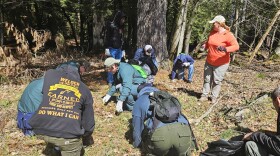
The Stream
So many of us live in Wisconsin’s Northwoods or Michigan’s Upper Peninsula because we love what surrounds us every day. We love the clear water, the clean air, and the lush forests. WXPR’s environmental reporting as part of our expanded series, The Stream, focuses on the natural world around us. The Stream is now about more than just water: it brings you stories of efforts to conserve our wild lands and lakes, scientific studies of animal and plant life, and potential threats to our environment.
What do you wonder about the environment in our region? Ask us a question and it could be a future story on The Stream! Use the form below to submit your question.
Latest Episodes
-
Trees for Tomorrow in Eagle River has several invasive species it’s working to remove from its campus.The work happened to align with a new program Blackwell Job Corps in Forest County is piloting.
-
In northern Iron County sits more than 3,000 acres of a largely undeveloped flowage along the west branch of the Montreal River.The Gile Flowage will remain that way after the county is set to receive more than $4 million in federal funding to conserve it.
-
For WXPR’s The Stream, Hannah Davis-Reid spoke with environmental experts about how the USDA's land management plan revisions impacts the Chequamegon- Nicolet National Forest.
-
Emerald Ash Borer has decimated ash tree population in the U.S. since the early 2000s.The invasive species has slowly been making its way north in Wisconsin and Michigan.Researchers with the USDA Forest Service Northern Research Station are working to get the species under control while also trying to restore ecosystems that have been destroy by them.
-
The upper Midwest rarely sees the type of high-intensity, destructive wildfires that the west coast sees, but that doesn’t mean it can’t happen here.The Ottawa National Forest works to make sure if such a fire happened in the U.P., people and homes have the best chance of surviving.
-
For more than a decade now, the Lac du Flambeau School District has brought back a piece of Ojibwe culture that had been missing for nearly two centuries. The Winter Games give students a chance to learn about their culture while having some fun. But a growing concern is how climate change may impact the games.
-
while the higher than average temperatures we’ve been experiencing this winter are because of El Niño, Vavrus says Wisconsin has also been experiencing warmer winters due to climate change, with the last 25 years generally well above normal compared with previous years.
-
A group of college students from Milwaukee are spending this week at Kemp Natural Resources Station at Woodruff.They’re collecting data and testing their hypotheses.The catch? They’re not science students.
-
For decades, the Keweenaw Peninsula in the U.P. was home to more than 100 copper mines.One of the byproducts of that is stamp sands, the practice of crushing rock and extracting heavy metals.Remnants of it are still found throughout the peninsula.
-
There are numerous insects that threaten the health of forests.One of the greatest challenges is finding them fast enough to stop the pests before they do irreversible damage.For WXPR’s The Stream, Katie Thoresen spoke with a Rhinelander-based scientist leading a project to try and meet this challenge.It’s part two of our series highlighting local researchers who have received Bipartisan Infrastructure Law funding.











